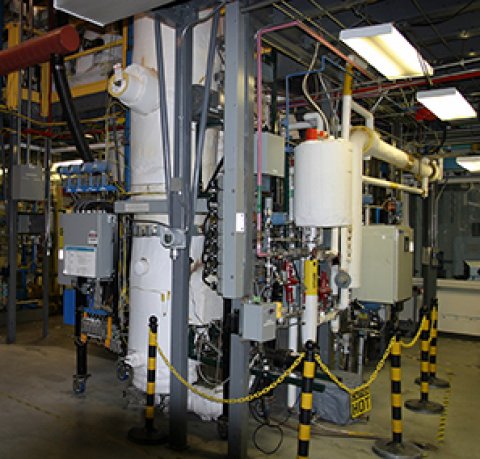Liquids derived from biomass resources—including ethanol and bio-oils—can be reformed to produce hydrogen in a process similar to natural gas reforming. Biomass-derived liquids can be transported more easily than their biomass feedstocks, allowing for semi-central production or possibly distributed hydrogen production at fueling stations. Biomass-derived liquid reforming is a mid-term technology pathway.
How Does It Work?
Biomass resources can be converted to cellulosic ethanol, bio-oils, or other liquid biofuels. Some of these liquids may be transported at relatively low cost to a refueling station or other point of use and reformed to produce hydrogen. Others (for example, bio-oils) may be reformed on-site.
The process for reforming biomass-derived liquids to hydrogen is very similar to natural gas reforming and includes the following steps:
- The liquid fuel is reacted with steam at high temperatures in the presence of a catalyst to produce a reformate gas composed mostly of hydrogen, carbon monoxide, and some carbon dioxide.
- Additional hydrogen and carbon dioxide are produced by reacting the carbon monoxide (created in the first step) with high-temperature steam in the "water-gas shift reaction."
- Finally, the hydrogen is separated out and purified.
Steam reforming reaction (ethanol)
C2H5OH + H2O (+ heat) → 2CO + 4H2
Water-gas shift reaction
CO + H2O → CO2 + H2 (+ small amount of heat)
Biomass-derived liquids, such as ethanol and bio-oils, can be produced at large, central facilities located near the biomass source to take advantage of economies of scale and reduce the cost of transporting the solid biomass feedstock. The liquids have a high energy density and with some upgrading can be transported with minimal new delivery infrastructure and at relatively low cost to distributed refueling stations, semi-central production facilities, or stationary power sites for reforming to hydrogen.
Why Is This Pathway Being Considered?
Biomass is an abundant domestic resource.
In the United States, there is more biomass available than is required for food and animal feed needs. A recent report projects that with anticipated improvements in agricultural practices and plant breeding, up to 1 billion dry tons of biomass could be available for energy use annually. This equates to around 13–14 quadrillion Btu/year potential (in 2030). Biomass has the potential to be a major contributing source of renewable energy. For more information, see U.S. Billion-Ton Update: Biomass Supply for a Bioenergy and Bioproducts Industry.
Biomass "recycles" carbon dioxide.
Plants consume carbon dioxide from the atmosphere as part of their natural growth process as they make biomass, off-setting the carbon dioxide released from producing hydrogen through biomass gasification and resulting in low net greenhouse gas emissions.
Research Focuses on Overcoming Challenges
Reforming biomass-derived liquids is a process very similar to reforming natural gas (a relatively mature technology). However, biomass-derived liquids are composed of larger molecules with more carbon atoms than natural gas, making them more difficult to reform. Research is needed to identify better catalysts to improve yields and selectivity. Other challenges include:
- Reducing the cost of biomass-derived liquids (research conducted by DOE's Office of Energy Efficiency and Renewable Energy Bioenergy Technologies Office)
- Reducing capital equipment costs, as well as operation and maintenance costs, and improving process efficiency (similar to the challenges of natural gas reforming).


